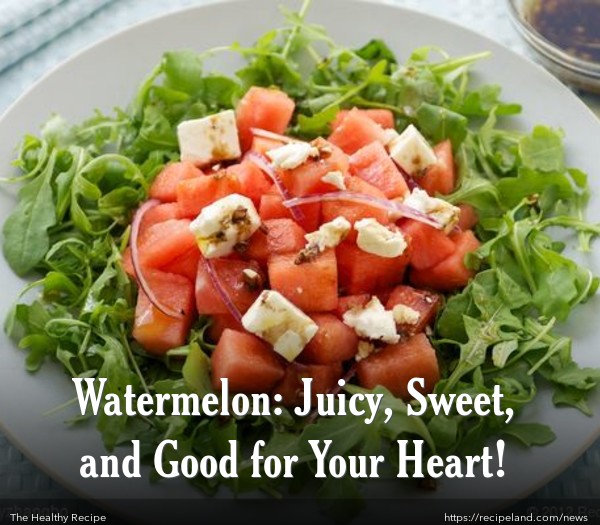As the temperature rises, fresh seasonal fruit becomes the perfect dessert or treat. What’s easier than cutting into a watermelon and sharing it with friends and family. Its juicy, yet crisp, texture and slightly sweet flavor go well with almost any meal. When watermelon is in season, it is an inexpensive way to feed a large crowd. Not only is watermelon a delicious treat, scientists are finding that it is extremely good for you!
Watermelon gets its name from its juicy texture. The flesh of watermelon is 92% water, but it still has an amazing crispness. You will often see both round and oblong shaped watermelons in local grocery stores. They can be personally-sized, weighing only a few pounds or huge, weighing up to 90 pounds.
The flesh of watermelon is most often red or pink, but you can find varieties with yellow, white, or orange flesh as well. China produces the largest amount of watermelons worldwide. Watermelon is available year-round in most grocery stores, although its peak season in the United States is from May to July.
You might also see watermelons that are labelled seedless. These watermelons still contain small white seed coats and are not the result of genetic engineering. Seedless watermelons are actually a hybrid between two types of watermelon. Nearly 85% of the watermelons grown in the U.S. are seedless.
Heart Healthy
Watermelon is packed with lycopene. This carotenoid phytonutrient is essential for a healthy heart and could be good for your bones as well. The rosy pink to deep red color of watermelon flesh comes from lycopene. The longer your watermelon ripens, the more lycopene it contains, so allow your watermelon to fully ripen before you enjoy it.
Lycopene acts as an antioxidant to neutralize dangerous free radicals and as an anti-inflammatory to reduce inflammation throughout your body. Watermelon with pink or red flesh has more lycopene than varieties with white or yellow flesh.
You don’t have to rush to finish your watermelon once it has been cut! Research has shown that the levels of lycopene within watermelon do not deteriorate until seven days after slicing, and even then it is only by a small amount. So feel free to slice your watermelon, store it in the refrigerator and enjoy it over a few days.
Vitamin C
Watermelon is an excellent source of low-calorie vitamin C. You can get 16% of your daily recommended amount of of vitamin C in one serving of watermelon. This may seem low, but to get that 16% you are only using 2% of your daily recommended calories, if you follow a 1800 calorie diet. Vitamin C is a powerful antioxidant, protecting your cells from damage. Your body also uses vitamin C to make collagen for quick healing, help fight off infection, and aid in the absorption of iron.
Eat it to the Rind
Researchers have found that the most nutrient-dense area of a watermelon is just next to the rind. This area contains concentrated amounts of lycopene, vitamin C, flavonoids, and phenolic antioxidants. All areas of the watermelon flesh are full of nutrients, but the outer area has the greatest amount.
Citrulline
Watermelon is unique in the high amount of cirtulline it contains. This amino acid is used by our kidneys to create arginine. Arginine is an amino acid that helps support blood flow throughout the body and supports heart health. Premlinary studies have shown that in animals the process of converting citrulline to arginine can keep excess fat from building up in fat cells.
Choosing and Storing a Juicy Watermelon
Most grocery stores sell watermelon that is whole, halved, sliced, or chunked. If you want watermelon that has already been cut, look for flesh that is firm, with deeply red or white colored flesh. The color of watermelon flesh should be uniform, without any streaking. Do not buy prepared watermelon that appears to be mushy or dull in color. At best watermelon that looks like this will be weak in flavor, at worst it will have an unappealing, mealy texture.
A whole watermelon should feel heavy for its size. The amount of water in watermelon flesh increases as it ripens, so a fully ripened watermelon should be heavy. The watermelon should feel smooth and should not have any bruising, cuts, discoloration, or mold. If the area of the watermelon that set on the ground as it grew, also called the ground spot, is bright green or white, the watermelon is not ripe. It should be a buttery yellow color. The rind can be any color of green, from bright to dark. Some shoppers like to thump watermelon to test it for ripeness. A ripe watermelon should have a deep hollow sound when thumped.
Watermelon needs to be stored in a cool area, between 50 and 60 degrees F (like a basement or cellar), until it is fully ripe. Once you have cut into your watermelon, it will stay fresh in the refrigerator in a sealed container for about six days. Storing an uncut watermelon in the fridge can damage its flavor and shorten its shelf life. Do not store whole watermelon near gas releasing fruits like apples, peaches, or pears. These will cause your watermelon to ripen too quickly.
Preparing Watermelon
Even though you will probably discard the watermelon rind it is important to thoroughly wash and dry your watermelon before cutting into it. The germs and surface dirt on an unclean rind will be transferred to the flesh as your knife passes through. It can be awkward to clean larger watermelons in a sink so remove visible dirt with a clean, wet towel instead.
Once your watermelon is clean, carefully cut it in half. At this point, you have many choices for serving your watermelon. Cut it into chunks, slices, or wedges. You could also use a melon baller to scoop it into balls. Eat your watermelon as it is or add it to your favorite recipe or punch. Watermelon flesh can also make a delicious juice.
Discard the rind or use it to make watermelon pickles.
Recipes:
Dessert:
Watermelon and Low Fat Vanilla Yogurt Ice
Maple Watermelon and Pineapple Popsicles
Fresh Watermelon with Cool Citrus Mascarpone
Salad:
Cherry Tomato and Watermelon Salad
Watermelon, Mint and Feta Salad with Citrus Dressing
Watermelon, Arugula and Feta Salad
Rind:










Comments